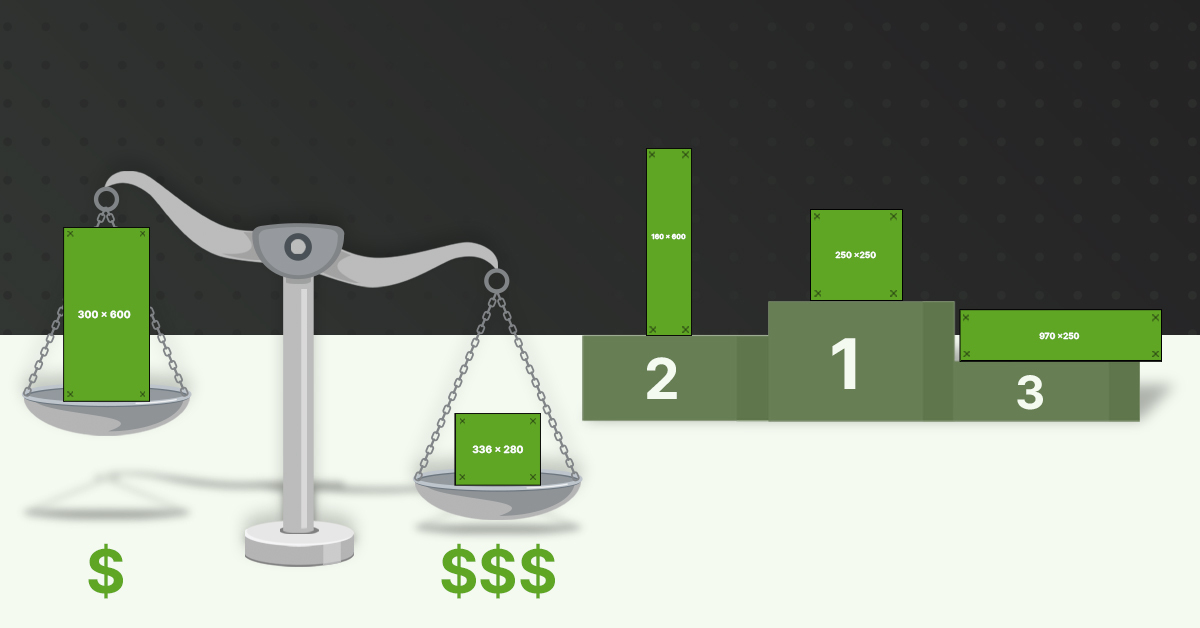Not every ad placeholder is made equal. If you simply shove as many ads as possible on your site, you may earn more in the short term, but burn your audience and cause them to ditch your site entirely in the long run.
But there are several ad units that simply work; they have become standard and normalized as a highest-earning ad unit for different sites over years and years of appearing all over the internet. These are unobtrusive and widely recognized by users everywhere. If your site is using the following ad units on your page, you’re setting yourself up for success in terms of balancing ad revenue and a high-quality user experience.
Ezoic recently created a brand new button that fully optimizes your entire site so that your site’s whole advertisement structure earns you the most revenue possible (while still creating a high-quality experience for your audience). It’s nearly impossible to manage every variable and ad unit on every page for every visitor, and Ezoic’s AI determines the optimal ad units for every visitor.
Still, the savviest publishers should acquaint themselves with the highest-earning ad units so they can make more informed decisions in the future.
Highest-Earning Ad Units for Ezoic Sites
1. Anchor Ad
Easily the highest-earning advertisement by a wide margin, anchor ads come in both bottom and top of page, waiting to load until the user scrolls past content so the ad doesn’t obscure any content. This ad stays on the users screen until they manually close it, meaning it has enormous visibility and extended accessibility for any visitors.
In more specific terms, anchor ads are a type of advertisement that are placed at the bottom or top of a webpage and remain visible as the user scrolls through the content. They are called “anchor” ads because they are anchored to a fixed position on the screen. Anchor ads are considered to be one of the highest-earning ad types for several reasons:
- Visibility: Anchor ads have a high visibility factor because they are constantly present on the screen, regardless of the user’s scrolling behavior. This ensures that the ad remains in the user’s view for an extended period, increasing the likelihood of engagement and conversions.
- User Attention: Since anchor ads are constantly visible, they have a higher chance of capturing the user’s attention compared to other ad formats. Users are more likely to notice and interact with an ad that remains in a fixed position while they navigate the webpage.
- Format and Size: Anchor ads often have a larger size compared to other ad formats, allowing for more creative and engaging content. The larger size provides advertisers with more space to deliver their message effectively and attract the user’s attention.
- Performance Metrics: Anchor ads tend to have higher click-through rates (CTR) and viewability rates compared to other ad types. The continuous visibility and prominent placement contribute to better performance metrics, leading to higher earnings for advertisers.
- Demand and Competition: Due to their effectiveness and higher engagement rates, anchor ads often generate greater demand from advertisers. The increased demand drives up the competition for ad placements, resulting in higher bids and ultimately higher earnings for publishers.
- Advertiser Preferences: Advertisers often prefer anchor ads because they are more likely to generate quality leads and conversions. The persistent visibility and engagement potential make them an attractive option for advertisers looking to maximize their return on investment (ROI).
It is important to note that the earning potential of anchor ads can vary depending on factors such as the website’s traffic, audience demographics, and industry vertical. Additionally, user experience and ad relevance should be carefully considered to ensure that the presence of anchor ads does not negatively impact the overall user experience of the website.
If you turn on the “Maximize Your Site’s Revenue” button, Ezoic’s AI will ensure these anchor ads appear the maximum number of times to increase your ad revenue while maintaining great user experience. In any case, anchor ads are an absolute must-have for publishers looking to earn the most ad revenue on their site.
2. Top of Page
The next highest-earning ad probably isn’t a big surprise — top of page ads. They’re typically large banner ads that take up a sizable portion of the users’ screens, impossible to miss and easy to see. Advertisers typically must enter a fierce bidding war for this real estate on highly-trafficked sites, ensuring publishers see the most revenue for top of page ads.
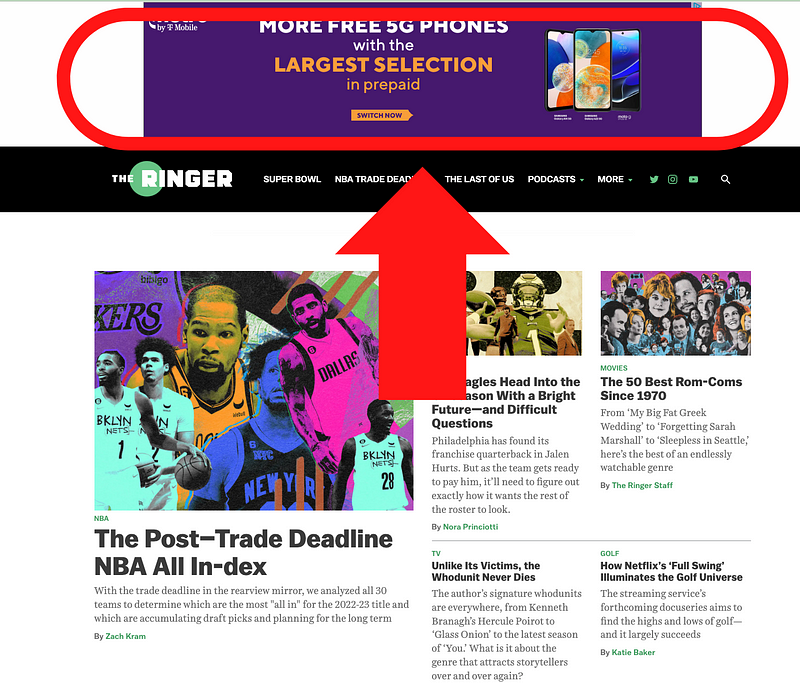
Top of page ads, also known as header ads or header banner ads, are another popular ad type that can generate high earnings. These ads are typically placed at the top of a webpage, above the main content, and are among the first elements that users see when they visit a website. Here’s why top of page ads can be lucrative:
- Prime Visibility: Similar to anchor ads, top of page ads benefit from excellent visibility. They are prominently displayed at the beginning of the webpage, ensuring that users are likely to notice them immediately. The high visibility increases the chances of capturing users’ attention and driving engagement.
- First Impression: Top of page ads have the advantage of being the first thing users see when they arrive on a webpage. This prime position allows advertisers to make a strong first impression and increase brand recall. Users are more likely to interact with an ad when they are initially engaged and receptive to the content.
- Ad Format and Size: Like anchor ads, top of page ads often have larger sizes compared to other ad formats. The increased size provides advertisers with more space to deliver compelling visuals, messages, and calls-to-action. This enables advertisers to create impactful and eye-catching ad campaigns.
- Competitive Bidding: The top of the page ad placement is highly sought after by advertisers due to its prominent position. Consequently, there is typically strong competition among advertisers to secure this prime ad space. Increased competition results in higher bids for these placements, leading to higher earnings for publishers.
- Ad Blocker Resistance: Some users employ ad-blocking software or browser extensions to prevent ads from displaying on webpages. However, top of page ads are less likely to be blocked by ad blockers since they are placed in a standard and noticeable position that is not easily filtered out.
- Premium Placement: Top of page ads are often associated with premium inventory, meaning they are displayed on high-traffic and high-quality websites. Advertisers are willing to pay a premium for these placements due to the perceived value and reach of the audience. Consequently, publishers can earn higher revenue by offering top of page ad placements.
Some publishers may worry top of page ads are supremely annoying to their users, and will push users away from their site. Not so! In a recent study conducted by Hubspot, a whopping 56% of people revealed that pop-up ads were the most annoying type of ad, while less than 6% of people said they found banner/top of page ads to be the most annoying.
3. Vignette
As Google explained, “Vignette ads are full-screen ads that appear between page loads and can be skipped by users at any time. Vignettes are displayed when the user leaves a page, rather than when they arrive on one, so the user doesn’t have to wait for them to load.” These ads have seen an enormous rise in popularity recently, earning publishers significant income while being a more seamless ad experience for users.
This is due in large part because Google introduced full-screen ads for larger and wider screens (like desktops) in November 2020, which allowed a more widespread use of vignette ads.
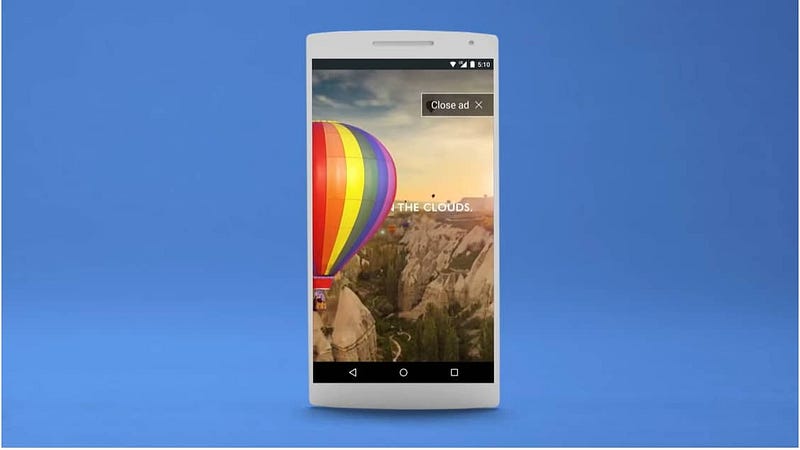
Vignette ads, also known as full-screen ads or interstitial ads, are another type of ad format that can generate significant earnings. These ads are displayed as full-screen overlays that appear between content transitions, such as when a user moves from one webpage to another or during natural breaks in an app or game. Here are some reasons why vignette ads can be highly profitable:
- Full-Screen Impact: Vignette ads occupy the entire screen, providing advertisers with maximum visibility and impact. With no distractions from surrounding content, these ads have a higher chance of capturing users’ attention and conveying the advertising message effectively.
- Engaging and Immersive: Vignette ads often utilize rich media formats, such as interactive videos, animations, or interactive elements, to create an immersive and engaging user experience. The full-screen nature of these ads allows advertisers to deliver their message in a more captivating and memorable way, leading to higher engagement rates.
- Forced Engagement: Since vignette ads typically appear during natural breaks or transitions, users are more likely to engage with the ad. For example, when a user is waiting for a new webpage to load, they may interact with the vignette ad displayed during the transition. This forced engagement can result in higher click-through rates and conversions.
- Higher Monetization Rates: Vignette ads often command higher monetization rates compared to other ad formats. Advertisers recognize the value of capturing users’ undivided attention through full-screen experiences, making them willing to pay a premium for these placements. As a result, publishers can earn higher revenue per impression.
- Advertiser Demand: Vignette ads are favored by advertisers because they offer a high-impact ad experience that is difficult to ignore. The demand for this ad format is often high due to its effectiveness in driving brand awareness, engagement, and conversions. Increased demand from advertisers leads to more competition and higher earnings for publishers.
- Targeting Capabilities: Vignette ads can leverage advanced targeting capabilities to reach specific audiences with tailored messages. Advertisers can employ demographic, behavioral, or contextual targeting to ensure their ads are shown to users who are more likely to be interested in the advertised products or services. This targeted approach increases the likelihood of generating valuable conversions.
4. Under Page Title
Similar to top of page ads, under page title ads are far more prone to earn more revenue as an ad unit simply based on their prime location on a page and the possibility for advertisers financially competing with each other to fill that slot:
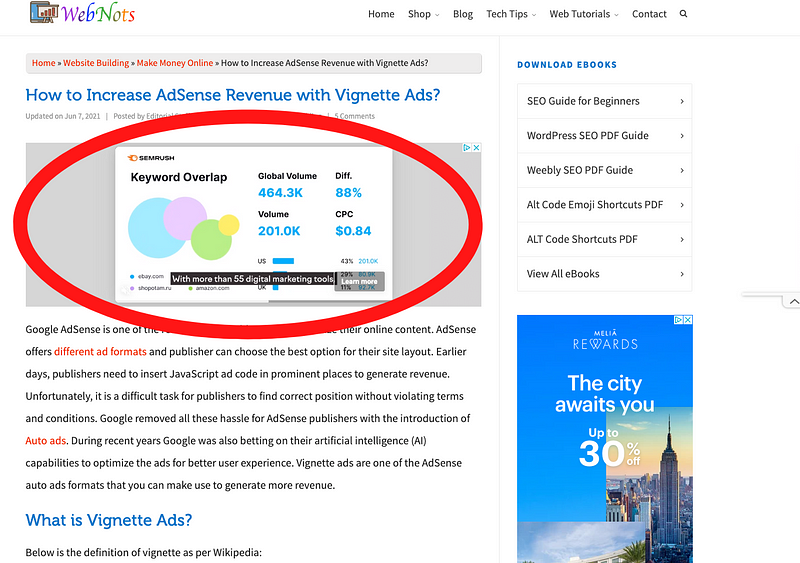
Under page title ads, also known as inline ads or content ads, are advertisements that are placed directly below the title or heading of a webpage or article. These ads are integrated within the content flow and are designed to be relevant to the page’s topic or the user’s interests. Here’s why under page title ads can be effective in generating earnings:
- Contextual Relevance: Under page title ads are strategically placed in close proximity to the main content or topic of the webpage. This positioning allows for greater contextual relevance, as the ads can align with the user’s interests and the content they are currently viewing. When the ad is relevant to the user’s intent, it increases the likelihood of engagement and conversions.
- Non-Intrusive Integration: Unlike more disruptive ad formats, under page title ads blend seamlessly with the content and do not interrupt the user’s reading or browsing experience. They are integrated within the natural flow of the page, maintaining a non-intrusive approach that minimizes user annoyance. This integration helps to retain user engagement and reduces the likelihood of ad blindness.
- Higher Click-Through Rates (CTR): The placement of under page title ads in a prominent position—usually near the beginning of the content—increases the chances of attracting user attention. When the ad is relevant, well-designed, and aligned with the user’s interests, it can lead to higher click-through rates. This increased engagement translates into higher earnings for publishers.
- Native Advertising Appeal: Under page title ads often resemble the style and formatting of the surrounding content, giving them a native advertising appeal. Native ads are designed to blend in seamlessly with the overall content, providing a more cohesive and integrated user experience. The less obtrusive and more organic nature of these ads can improve user acceptance and engagement.
- Advertiser Demand: Advertisers value under page title ad placements due to their contextual relevance and effective targeting potential. By aligning their ads with relevant content, advertisers can reach users who are actively engaged with the topic and more likely to convert. The demand from advertisers for such targeted and integrated placements can result in higher bids and increased earnings for publishers.
- Improved User Experience: Under page title ads, when implemented thoughtfully, can enhance the user experience by providing additional relevant information or offers related to the content. When the ads add value and are non-disruptive, users may view them as helpful recommendations, which can positively impact engagement and ad performance.
This is a highly lucrative ad unit, one that can easily become one of your biggest earners for ads on your pages. They are also widely accepted and recognized by a vast majority of internet users, and have minimal interruption for readers who scroll down to see more of your content.
5. Under First Paragraph
If you’re noticing a trend here, it’s true: the most lucrative ads are typically the ones that are the most visible and difficult-to-miss for the average site visitor. Your highest-earning ads typically appear at the top of the page, where visitors are bound to see it.
Ads under the first paragraph are no exception; advertisers are more prone to bid for these higher-visibility slots where users are practically guaranteed to see the ad:
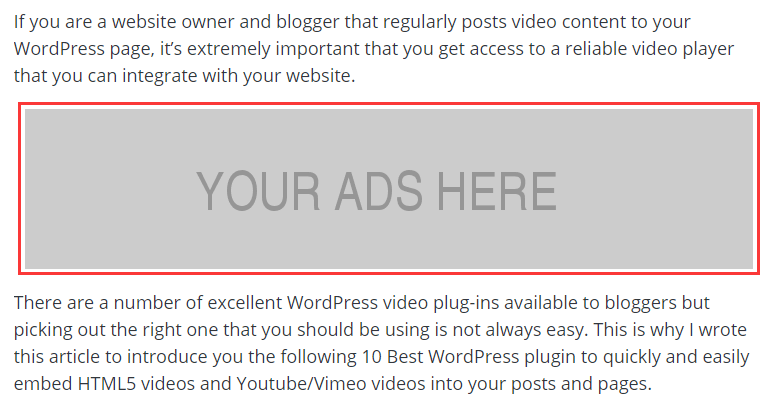
Under first paragraph ads, also known as in-content ads or paragraph ads, are advertisements that are placed directly below the first paragraph of an article or webpage. These ads are designed to capture users’ attention early in their reading experience. Here are some reasons why under first paragraph ads can be effective in generating earnings:
- Early User Engagement: Placing ads below the first paragraph ensures that users encounter the ad early in their reading experience. At this point, users are typically more engaged and receptive to the content, making them more likely to notice and interact with the ad. The early placement increases the chances of capturing user attention and driving engagement.
- Seamless Integration: Under first paragraph ads are integrated within the content flow, making them appear more natural and less disruptive. When the ad seamlessly blends with the surrounding text and formatting, it becomes less obtrusive and reduces the likelihood of ad blindness. This integration enhances the overall user experience and improves the effectiveness of the ad.
- Relevance and Context: Under first paragraph ads can be contextually relevant to the content being consumed by the user. By aligning the ad with the topic or theme of the article, advertisers can provide relevant offers or information that is likely to be of interest to the user. The increased relevance enhances the ad’s effectiveness and the likelihood of user engagement.
- Higher Click-Through Rates (CTR): The placement of under first paragraph ads near the beginning of the article or webpage increases their visibility and click-through potential. When users are still engaged and motivated to explore the content further, they are more likely to click on relevant ads that appear in close proximity. This can result in higher click-through rates and increased earnings.
- Enhanced Monetization: Under first paragraph ads are considered prime ad placements due to their early position in the content hierarchy. Advertisers often value these placements more, resulting in higher bids and increased monetization opportunities for publishers. The competitive demand for these placements can lead to higher earnings.
- Targeting Capabilities: Advertisers can leverage advanced targeting capabilities to ensure that under first paragraph ads are shown to specific audiences. By using demographic, behavioral, or contextual targeting, advertisers can deliver ads that are highly relevant to the user’s interests and increase the chances of generating valuable conversions.
Now that we know which types of ad units are the highest-earning ad units, let’s go one level deeper and talk about ad sizes by revenue. According to our most recent data, the following are the highest-earning ad sizes:
Highest-Earning Ad Units by Size
300×250
As Newspack revealed, this size is the most popular, accounting for 40% of display ads served across the web. This size is most often found in the sidebar on desktop or inline on mobile.

It’s a classic, and seamlessly fits across the board for mobile, tablet, and desktop.
The 300×250 ad size is highly lucrative due to its versatile placement options, high demand from advertisers, increased visibility, and advertiser preference.
The versatility of the 300×250 ad size allows it to be seamlessly integrated into different website layouts and positions, ensuring it can reach a wide audience. Advertisers can place it within the content, sidebar, or at the end of an article, maximizing its exposure and effectiveness.
The high demand for the 300×250 ad size stems from its popularity and effectiveness. Many ad campaigns are specifically designed for this size, leading to increased competition among advertisers. Higher competition translates to higher bids, resulting in higher earnings for publishers.
The 300×250 ad size offers a balance between being attention-grabbing and non-intrusive. Its larger size makes it more noticeable than smaller ad formats, increasing the chances of capturing users’ attention. However, it is not overly obtrusive, allowing users to engage with the content while still being exposed to the ad.
Advertisers often prefer the 300×250 ad size due to its proven effectiveness in driving engagement and conversions. It provides enough space for creative and compelling ad content without being overwhelming. Its popularity and performance make it a go-to choice for many advertisers, further driving its demand and earnings potential.
In conclusion, the 300×250 ad size is lucrative because of its versatile placement options, high demand from advertisers, increased visibility, and advertiser preference. Its effectiveness in capturing user attention and driving engagement contributes to its earning potential for publishers.
728×90
According to The Online Advertising Guide, this size is “commonly called a 728×90 or Leaderboard, but can also be referred to as a Leaderboard Banner or Super Banner. A 728×90 ad is usually placed at the top of a webpage so that it will be seen immediately when the page loads.”
This is a classic banner ad that can fit a variety of sites, especially on desktop as a large top-of-page ad.

The 728×90 ad size, also known as the leaderboard, is a lucrative ad format due to its prominent placement and ample ad space.
The 728×90 leaderboard ad is usually positioned at the top of a webpage, making it highly visible to users. Its prime placement ensures that it is one of the first elements users encounter, increasing the likelihood of capturing their attention and generating engagement.
The ad size itself provides ample space for advertisers to deliver their message effectively. With a wide aspect ratio, the 728×90 ad allows for creative and visually appealing designs, compelling calls-to-action, and sufficient room for engaging content.
Due to its prominent placement and generous ad space, the 728×90 ad format often attracts higher demand from advertisers. Advertisers recognize the value of capturing users’ attention at the top of the webpage and are willing to bid more for these placements, resulting in higher earnings for publishers.
The leaderboard ad format is particularly suitable for branding campaigns, as it allows advertisers to showcase their brand logo, tagline, and other key elements prominently. Its wide dimensions and visibility make it an effective tool for building brand awareness and recognition.
In summary, the 728×90 leaderboard ad size is lucrative due to its prominent placement, ample ad space, higher demand from advertisers, and its effectiveness in branding campaigns. Its visibility and wide aspect ratio make it an attractive choice for advertisers, leading to higher earnings potential for publishers.
320×100
As Directive Consulting noted, the 320×100 ad placeholder is particularly high-earning on mobile devices as ads, due to their small, versatile nature (you can fit them in nearly every ad placeholder slot on your site):

The 320×100 ad size, also known as the large mobile banner or mobile leaderboard, is a format that can be lucrative for several reasons.
First, the 320×100 ad size is specifically designed for mobile devices, catering to the increasing number of users accessing content through their smartphones and tablets. With mobile usage on the rise, advertisers recognize the importance of reaching this audience effectively. The 320×100 format allows for optimal visibility and display on mobile screens, ensuring that the ad can capture users’ attention.
Second, the larger size of the 320×100 ad provides more room for creative elements and messaging. It offers advertisers an opportunity to convey their message more effectively compared to smaller ad sizes. The increased space allows for eye-catching visuals, clear calls-to-action, and engaging content, all of which contribute to higher user engagement and click-through rates.
Furthermore, the 320×100 ad size is often placed in prime positions within mobile apps or mobile webpages. It is commonly positioned at the top or bottom of the screen, allowing it to be one of the first elements users see when they interact with content on their mobile devices. This prominent placement increases the likelihood of capturing users’ attention and driving engagement.
Advertisers value the 320×100 ad format for its mobile-focused design and effectiveness. Mobile advertising has become a crucial component of digital marketing strategies, and advertisers are willing to invest in formats that effectively target mobile users. The demand for this ad size contributes to higher competition and potentially increased earnings for publishers.
In conclusion, the 320×100 ad size is lucrative due to its mobile-specific design, larger space for creative elements, prominent placement within mobile content, and the growing demand from advertisers targeting mobile users. Its effectiveness in capturing mobile users’ attention and driving engagement makes it a valuable ad format for publishers.
3×3 (Vignette)
As we noted earlier, vignette ads have seen a surge in popularity in the past few years. Advertisers are willing to pay higher rates to show a fullscreen vignette ad, while still remaining a minimal interruption as users can simply close the ad at any time.
What Publishers Should Do With This Information
There are literally endless variables that determine and dictate user behavior on your site: traffic source, device type, country of origin, whether they’re on WiFi (public or private?) vs cellular data (are they home or traveling?), not to mention the utterly unique web browsing behavior each user is connected with.
It’s literally impossible to plan for every visitor’s optimal user experience on your site. The result is typically a net negative in both revenue and user experience; you either show too few ads (of the wrong type/placement) in hopes of elevating user experience, or you have too many (of the wrong type/placement) which causes the user to leave your site anyway.
The point here? Let AI and machine-learning do this work for you. Savvy publishers will understand placeholder sizes and strategy, yet Ezoic’s AI should be doing the heavy lifting to fully maximize your revenue and optimize your site’s performance.
You can read more here about how to maximize your site revenue with the click of a button, but essentially, Ezoic recently created a brand-new feature to assess every possible ad unit, size, and feature of ad placeholders to create the most optimal revenue for you and your site.
